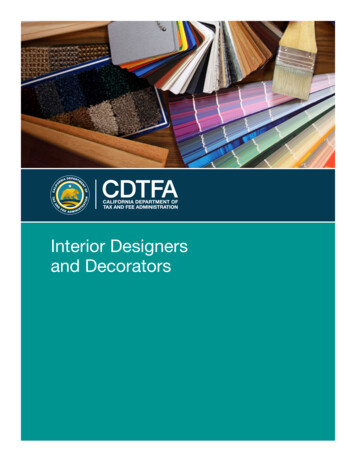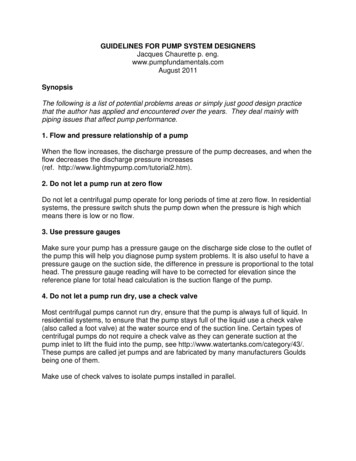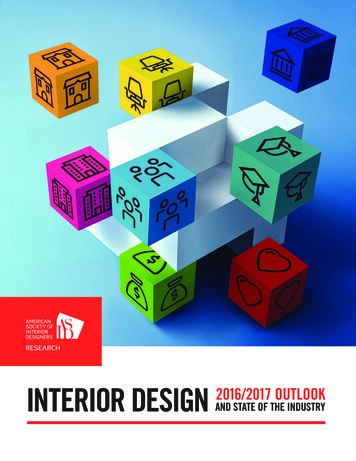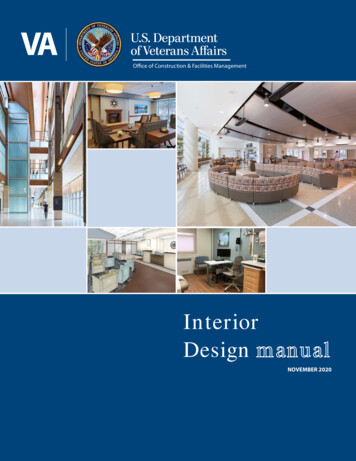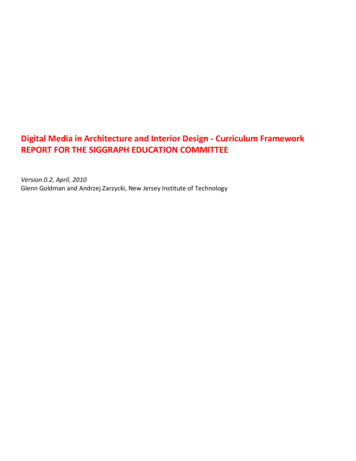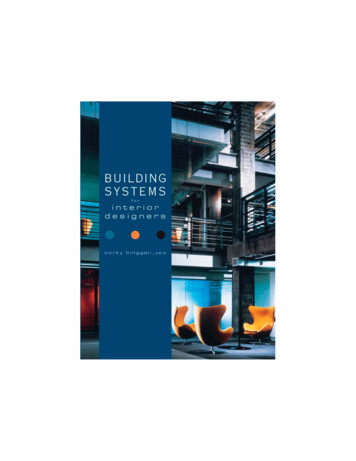
Transcription
BUILDING SYSTEMSFOR INTERIORDESIGNERSCORKY BINGGELIA . S . I . D.JOHN WILEY & SONS, INC.
BUILDING SYSTEMSFOR INTERIORDESIGNERS
BUILDING SYSTEMSFOR INTERIORDESIGNERSCORKY BINGGELIA . S . I . D.JOHN WILEY & SONS, INC.
This book is printed on acid-free paper. 䊊Copyright 2003 by John Wiley & Sons, Inc. All rights reservedPublished by John Wiley & Sons, Inc., Hoboken, New JerseyPublished simultaneously in CanadaNo part of this publication may be reproduced, stored in a retrieval system, or transmittedin any form or by any means, electronic, mechanical, photocopying, recording,scanning, or otherwise, except as permitted under Section 107 or 108 of the 1976 UnitedStates Copyright Act, without either the prior written permission of the Publisher, orauthorization through payment of the appropriate per-copy fee to the CopyrightClearance Center, Inc., 222 Rosewood Drive, Danvers, MA 01923, (978) 750-8400, fax(978) 750-4470, or on the web at www.copyright.com. Requests to the Publisher forpermission should be addressed to the Permissions Department, John Wiley & Sons, Inc.,111 River Street, Hoboken, NJ 07030, (201) 748-6011, fax (201) 748-6008, e-mail:permcoordinator@wiley.com.Limit of Liability/Disclaimer of Warranty: While the publisher and author have used theirbest efforts in preparing this book, they make no representations or warranties withrespect to the accuracy or completeness of the contents of this book and specificallydisclaim any implied warranties of merchantability or fitness for a particular purpose. Nowarranty may be created or extended by sales representatives or written sales materials. Theadvice and strategies contained herein may not be suitable for your situation. You shouldconsult with a professional where appropriate. Neither the publisher nor author shall beliable for any loss of profit or any other commercial damages, including but not limited tospecial, incidental, consequential, or other damages.For general information on our other products and services or for technical support, pleasecontact our Customer Care Department within the United States at (800) 762-2974,outside the United States at (317) 572-3993 or fax (317) 572-4002.Wiley also publishes its books in a variety of electronic formats. Some content thatappears in print may not be available in electronic books. For more information aboutWiley products, visit our web site at www.wiley.com.Library of Congress Cataloging-in-Publication Data:Binggeli, Corky.Building systems for interior designers / Corky Binggeli.p. cm.ISBN 0-471-41733-5 (alk. paper)1. Buildings—Environmental engineering. 2. Buildings—Mechanical equipment—Design and construction. 3. Buildings—Electric equipment—Design and construction.I. Title.TH6014 .B56 2003696—dc212002003197Printed in the United States of America10987654321
To my mother,who taught me to love learning,andto my father,who showed me how buildings are made.
CONTENTSPreface ixAcknowledgmentsxiPART ITHE BIG PICTUREChapter 1 Natural Resources 3Chapter 2 Building Site Conditions 12Chapter 3 Designing for BuildingFunctions 17Chapter 4 The Human Body and theBuilt Environment 21Chapter 5 Building Codes 25PART IIWATER AND 891011Sources of Water 31Water Quality 37Water Distribution 41Hot Water 45Waste Plumbing 50Treating and RecyclingWater 55Chapter 12 Recycling Solid Wastes 60Chapter 13 Plumbing Fixtures 66Chapter 14 Designing Bath andToilet Rooms 76PART IIITHERMAL COMFORTChapter 15 Principles of ThermalComfort 83Chapter 16 Thermal Capacity andResistance 93Chapter 17 Humidity 98Chapter 18 Mechanical EngineeringDesign Process 101Chapter 19 Indoor Air Contaminants108Chapter 20 Designing for IndoorAir Quality 121Chapter 21 Ventilation 136Chapter 22 Fenestration 143Chapter 23 Solar Heating 151PART IVHEATING ANDCOOLING SYSTEMSChapter 24 Heating Systems 161Chapter 25 Cooling 184Chapter 26 Heating,Ventilating, andAir-Conditioning (HVAC)Systems 194PART VELECTRICITYChapter 27 How Electrical SystemsWork 213Chapter 28 Electrical ServiceEquipment 224Chapter 29 Electrical Circuit Design 230Chapter 30 Electrical Wiring andDistribution 243Chapter 31 Receptacles and Switches 252Chapter 32 Residential Appliances 258vii
viiiCONTENTSPART VILIGHTINGChapter 33 Daylighting 269Chapter 34 Lighting Design 277Chapter 35 Lighting for SpecificSpaces 292PART VIISECURITY ANDCOMMUNICATIONS SYSTEMSChapter 36 Communications andControl Systems 303Chapter 37 Securing the Building 307Chapter 38 Systems for PrivateResidences 314Chapter 39 Other Security andCommunicationsApplications 318Chapter 40 Office CommunicationsSystems 321PART VIIIFIRE SAFETYChapterChapterChapterChapter43444546Escape Routes 349Limiting Fuels 354Fire Suppression 360Fire Detection andAlarms 368PART IXCONVEYING SYSTEMSChapter 47 Elevators 377Chapter 48 Escalators 386Chapter 49 Materials HandlingPART X390ACOUSTICSChapter 50 Acoustic Principles 395Chapter 51 Acoustic Design 403Chapter 52 Sound Absorption Withina Space 408Chapter 53 Sound Transmission BetweenSpaces 415Chapter 54 Acoustic Applications 424Chapter 55 Electronic SoundSystems 435Chapter 41 Principles of Fire Safety 333Chapter 42 Design for Fire Safety 338Index443
PREFACEThe inspiration for Building Systems for Interior Designerscame when I tried to teach interior design studentsabout all the ways buildings support our activities andphysical needs—without an adequate textbook. I neededan approach that supported the special concerns of theinterior designer, while connecting those issues to thework of the rest of the building design team. I had researched building systems in a number of excellent textsintended for architecture, engineering, and even hospitality management students, but I had found that noneof those texts taught the necessary combination of related subjects in adequate depth without an emphasison calculations and formulas.Interior design has a relatively short history as a profession requiring special training and demanding technical expertise. Over the past half-century, design professionals have evolved from decorators workingprimarily in private residences to critical contributors inthe design of commercial and residential buildings. Weare expected to apply building codes and to work closelywith engineers and architects. To do this, we must understand what the other members of the design teamhave to say, how they approach the design process, andhow they document their work.The more we know about the process of designingand constructing a building, the more effective impactwe can have on the results. To cite one example frommy own largely commercial interior design practice, mydiscussion with the mechanical engineer on a spa project of alternate methods of supplying extra heat to atreatment room resulted in a design that improved bothour client’s heating bills and his customers’ experience.The approach of architects and engineers to building design has changed from one of imposing the building on its site to one of limiting the adverse impact ofthe building on the environment by using resourcesavailable on site. Sustainable design requires that we select materials wisely to create healthy, safe buildings thatconserve energy. Sustainable design solutions cut acrossdisciplines, and successful solutions arise only when allthe members of the design team work together. As interior designers, we can support or sabotage this effort.We must be involved in the project from the beginningto coordinate with the rest of the design team. Thatmeans we must understand and respect the concerns ofthe architects and engineers, while earning their respectand understanding in return.Building Systems for Interior Designers is intended primarily as a textbook for interior design students. Thestyle strives for clarity, with concepts explained simplyand delivered in everyday language. Enough technicalinformation is offered to support a thorough understanding of how a building works. The illustrations areplentiful and designed to convey information clearlyand visually. I have kept in mind the many students forwhom English is a second language—as well as the common technophobes among us—as I wrote and illustrated this text. Featured throughout the book arespecial “Designer’s Tips.” Look for this iconto findhelpful professional advice on a wide range of topics.Building Systems for Interior Designers covers somesubjects, such as heating and air-conditioning systems,that are rarely included in other parts of an interior designer’s education. Other areas, such as lighting, typically have entire courses devoted to them, and are givena less thorough treatment here. While some topics, suchas acoustics or fire safety, are intimately tied to the workof the interior designer, others, such as transportationsystems, involve the interior designer less directly, ormay be absent from some projects altogether. This textassumes that the reader has a basic knowledge of building design and construction, but no special training inphysics or mathematics. I have sought to cover all therelated systems in a building in sufficient depth to provide the reader with a good general understanding,while avoiding repetition of material most likely covered in other courses and texts.As the book has evolved, it has become obvious thatthis material is also valuable for people involved in making decisions about the systems in their own buildings,ix
xPREFACEwhether they are homeowners or facilities managers.Practicing interior designers and architects will also findBuilding Systems for Interior Designers a useful referencewhen checking facts and researching options. Interiordesigners preparing for the National Council for Interior Design Qualification (NCIDQ) professional certification exam will also benefit from this text.Building Systems for Interior Designers has evolvedfrom an initial set of lecture notes, through an illustrated outline, to classroom handouts of text and illustrations, and finally into a carefully researched and writ-ten illustrated text. In the process, I have enriched myown understanding of how buildings support our needsand activities, and this understanding has in turn benefited both my professional work as an interior designerand my continuing role as a teacher. It is my hope that,through this text, I will pass these benefits along to you,my readers.Corky Binggeli A.S.I.D.Arlington, Massachusetts2002
ACKNOWLEDGMENTSThis book owes its existence to the support and talentsof many people. In targeting the needs of interior designers, I began by researching the materials alreadyavailable for students of architecture and engineering. Iam especially indebted to the Ninth Edition of Mechanical and Electrical Equipment for Buildings by Benjamin Stein and John S. Reynolds (John Wiley & Sons,Inc., NY, 2000), whose comprehensive and clear coverage of building systems was both a standard for excellence and a source for accurate information.I would never have started on the road to writingthis text without the encouragement of Professor RoseMary Botti-Salitsky IDEC, IIDA of Mount Ida College,and of Thomas R. Consi Ph.D. at the Massachusetts Institute of Technology, a dear friend whose faith in myability far exceeds my own. Professor Allan Kirkpatrickof Colorado State University shared his contacts and experience as a textbook author, providing the critical linkto making this book a reality.A number of friends and professional colleagues reviewed the manuscript before submission and offered extremely helpful comments on content and clarity. Theseinclude Felice Silverman IIDA of Silverman TrykowskiAssociates, Josh Feinstein L.C. of Sladen Feinstein Inte-grated Lighting, Associate Professor Herb Fremin ofWentworth Institute of Technology, and Edward T. Kirkpatrick Ph.D., P.E. Additional technical review was provided by Professor Arlena Hines ASIS, IDEC of LansingCommunity College, Professor Novem Mason of the University of North Carolina at Greensboro, Professor JoyceRasdall of Southeast Missouri State University, Jeff BarberAIA of Gensler Architecture, and Professor Janine King ofthe University of Florida. Their professional perspectivesand teaching experience helped keep the text accurate andfocused on the prospective reader, and their enthusiasmand encouragement were wonderfully motivating.I would also like to thank the staff at John Wiley &Sons, Inc., whose professionalism, support, and goodadvice guided my efforts. Executive Editor AmandaMiller and Developmental Editor Jennifer Ackermanworked closely with me to see that the text and illustrations reflected the intended content and spirit that Ienvisioned.Finally, I am deeply indebted to my husband, KeithKirkpatrick, who read and commented on every word ofthe text and who reviewed all of the illustrations as well.This book is a testament to his patience, insight, diligence, and steadfast support in a thousand small ways.xi
BUILDING SYSTEMSFOR INTERIORDESIGNERS
IP a r tTHE BIG PICTURE
1C h a p t e rNatural ResourcesLike our skins, a building is a layer of protection between our bodies and our environment. The buildingenvelope is the point at which the inside comes intocontact with the outside, the place where energy, materials, and living things pass in and out. The building’sinterior design, along with the mechanical, electrical,plumbing, and other building systems, creates an interior environment that supports our needs and activitiesand responds to the weather and site conditions outdoors. In turn, the environment at the building site ispart of the earth’s larger natural patterns.the oxygen we breathe, the plants we eat, and the fuelswe use for heat and power. Ultraviolet wavelengths makeup only about 1 percent of the sun’s rays that reach sealevel, and are too short to be visible. About half of theenergy in sunlight that reaches the earth arrives as visible wavelengths. The remainder is infrared (IR) wavelength
Interior design has a relatively short history as a pro-fession requiring special training and demanding tech-nical expertise. Over the past half-century, design pro-fessionals have evolved from decorators working primarily in private residences to critical contributors in the design of commercial and residential buildings. We are expected to apply building codes and to work closely with .
